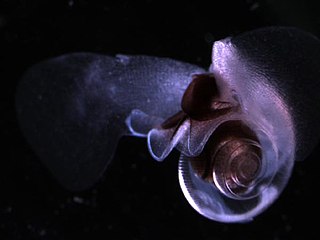
Sea butterflies, scientific name Thecosomata, are a taxonomic suborder of small pelagic swimming sea snails. They are holoplanktonic opisthobranch gastropod mollusks. Most Thecosomata have some form of calcified shell, although it is often very light and / or transparent.
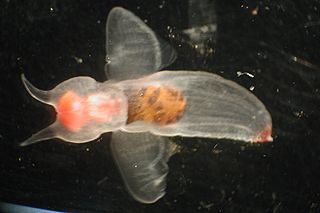
Sea angels are a large group of small free-swimming sea slugs, not to be confused with Cnidarians, classified into six different families. They are pelagic opisthobranchs in the clade Gymnosomata within the larger mollusc clade Heterobranchia. Sea angels were previously referred to as a type of pteropod.

Limacina is a genus of swimming predatory sea snails commonly known as sea butterflies in the family Limacinidae. This genus contains some of the world's most abundant gastropod species.
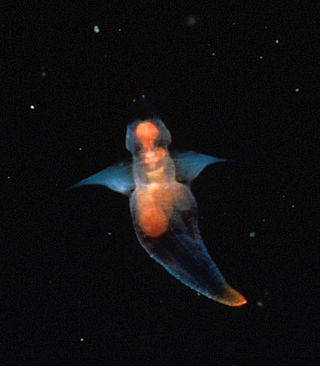
The Clionidae are a family of sea angels, which are a group of pelagic marine gastropods.
The Notobranchaeidae, or "naked sea butterflies", are a taxonomic family of floating sea slugs, specifically under the subclass Opistobranchia, also called "sea angels".

Clione is a genus of small, floating sea slugs, pelagic marine gastropod mollusks in the family Clionidae, the sea angels.

The Trochidae, common name top-snails or top-shells, are a family of various sized sea snails, marine gastropod molluscs in the subclass Vetigastropoda. This family is commonly known as the top-snails because in many species the shell resembles a toy spinning top.

Atlanta is a genus of pelagic marine gastropod molluscs in the family Atlantidae. They are sometimes called heteropods.

Carinaria is a genus of medium-sized floating sea snails, pelagic gastropod molluscs in the family Carinariidae.

Phylliroe is a genus of average sized, highly transparent pelagic nudibranchs, marine gastropod molluscs in the order Opisthobranchia, that consists of two known species. It is notable for being an open-ocean hunter that resembles a fish in body plan and locomotion, an example of convergent evolution.
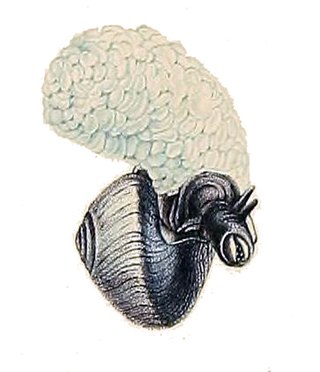
Janthina janthina is a species of holoplanktonic sea snail, a marine gastropod mollusk in the family Epitoniidae. Its common names include violet sea-snail, common violet snail, large violet snail and purple storm snail.

The Pterotracheoidea is, according to the Taxonomy of the Gastropoda, a taxonomic superfamily of sea snails or sea slugs, marine gastropod molluscs in the clade Littorinimorpha. They are commonly called heteropods or sea elephants.

Cymbulioidea is a taxonomic superfamily of pelagic "sea butterflies", one group of swimming sea snails. They are holoplanktonic opisthobranch gastropod molluscs in the clade Thecosomata.

Clione limacina, known as the naked sea butterfly, sea angel, and common clione, is a sea angel found from the surface to greater than 500 m (1,600 ft) depth. It lives in the Arctic Ocean and cold regions of the North Atlantic Ocean. It was first described by Friderich Martens in 1676 and became the first gymnosomatous "pteropod" to be described.

Limacina helicina is a species of small swimming planktonic sea snail in the family Limacinidae, which belong to the group commonly known as sea butterflies (Thecosomata).

Limacina rangii is a species of swimming sea snail in the family Limacinidae, which belong to the group commonly known as sea butterflies (Thecosomata).
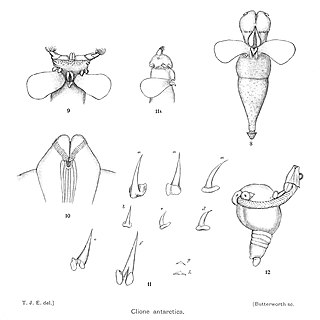
Clione antarctica is a species of "sea angel", a sea slug, a pelagic marine gastropod mollusk in the family Clionidae, the "sea angels".
Limacina retroversa is a species of swimming predatory sea snail in the family Limacinidae, that belongs to the group commonly known as sea butterflies (Thecosomata).

Carinaria cristata, commonly known as the glassy nautilus, is a species of pelagic marine gastropod mollusc in the family Carinariidae. It is found in the Pacific Ocean and is described as being holoplanktonic, because it spends its entire life as part of the plankton. It was first described by Carl Linnaeus in 1767. Its fragile shell was much prized by early conchologists for their collections, being so rare that it was said to be worth more than its weight in gold.
Clione okhotensis is a species of sea angel, a pelagic marine gastropod in the family Clionidae.













